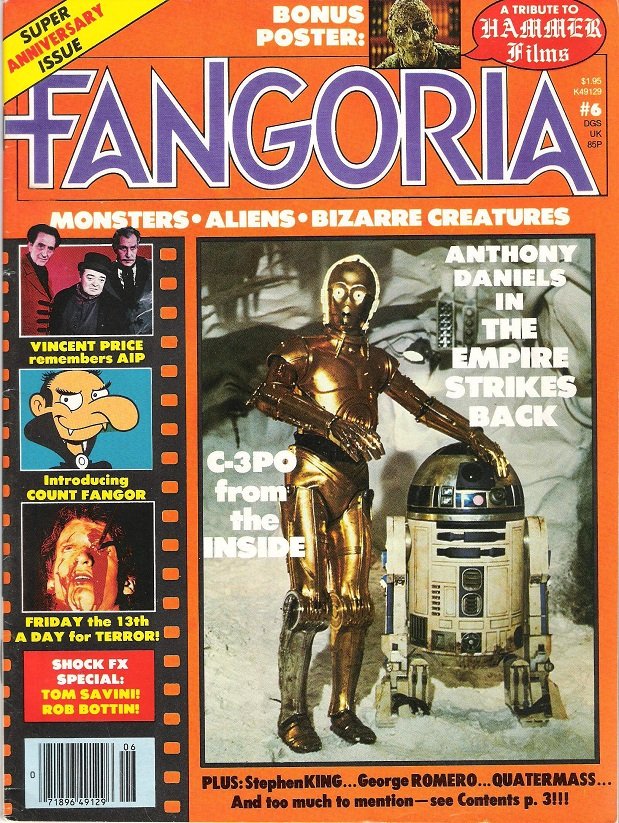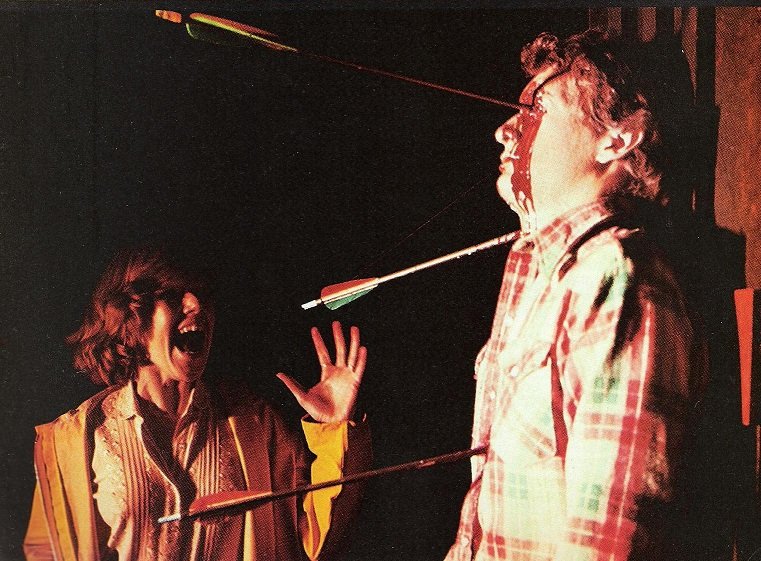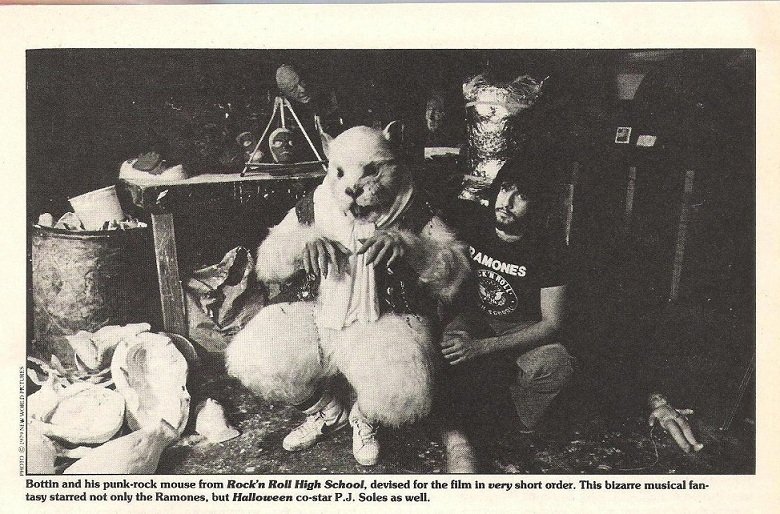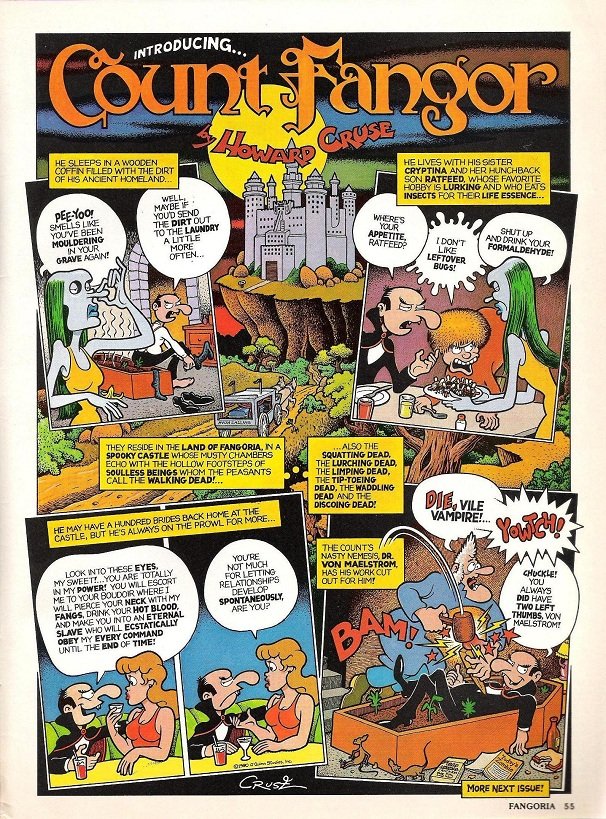THE FANGO FILES: Issue #06 - A Successful Venture Into Crimson Pastures
Now, this is where things really start cooking for this soon-to-be beloved institution. For reasons outlined in the essay on Fangoria #5, the forces-that-be allowed editor Bob Martin to try out a more horror-oriented direction in an attempt to bring in some much-needed profits. Issue #6 was the maiden voyage for this approach and it yielded plentiful dividends for genre fans. The end result still has a few problems and a couple of visible seams but it's also a big step forward into pleasingly horrific territory. The cover inspires a bit of fear by trumpeting an interview with Anthony Daniels, the actor who played C-3PO in the Star Wars films. Thankfully, this feature isn't as dominant as the cover makes it seems and is pleasant enough reading (Daniels comes off nicely, showing a self-deprecating sense of charm). It's also worth noting that the sci-fi element this article represents is a minority-level topic in this issue. The only other truly sci-fi articles in the issue are a piece on The Quatermass Conclusion that doubles as a thumbnail history of the Quatermass series and a short but informative overview of the Planet Of The Apes films. Both are smart, succinct and have enough crossover appeal to make them worth a read for the horror brigade.The re
The cover inspires a bit of fear by trumpeting an interview with Anthony Daniels, the actor who played C-3PO in the Star Wars films. Thankfully, this feature isn't as dominant as the cover makes it seems and is pleasant enough reading (Daniels comes off nicely, showing a self-deprecating sense of charm). It's also worth noting that the sci-fi element this article represents is a minority-level topic in this issue. The only other truly sci-fi articles in the issue are a piece on The Quatermass Conclusion that doubles as a thumbnail history of the Quatermass series and a short but informative overview of the Planet Of The Apes films. Both are smart, succinct and have enough crossover appeal to make them worth a read for the horror brigade.The re st of the magazine is dominated by horror articles. Bob Martin delivers a trio of worthwhile interviews with Tom Savini, Sean Cunningham and Peter Medak. The Savini interview, a followup to the successful interview from Fangoria #1, is intriguing because Savini talks as much about his love of acting as he does makeup effects. The Cunningham interview focuses on Friday The 13th and he's refreshingly honest about how the film borrows from Halloween and was designed to be a popcorn-movie hit with the horror crowd (little did he know how epoch-defining his humble effort would be). The Medak interview was done to promote The Changeling: Medak freely admits he d
st of the magazine is dominated by horror articles. Bob Martin delivers a trio of worthwhile interviews with Tom Savini, Sean Cunningham and Peter Medak. The Savini interview, a followup to the successful interview from Fangoria #1, is intriguing because Savini talks as much about his love of acting as he does makeup effects. The Cunningham interview focuses on Friday The 13th and he's refreshingly honest about how the film borrows from Halloween and was designed to be a popcorn-movie hit with the horror crowd (little did he know how epoch-defining his humble effort would be). The Medak interview was done to promote The Changeling: Medak freely admits he d id the film to boost his commercial standing and Martin gives the interview an artful frame by placing the film in the context of Medak's earlier, artsier efforts.And there's plenty more interviews where those came from. Future schlock-film auteur Jim Wynorski makes his Fangoria debut by interviewing makeup fx-whiz Rob Bottin. It was done as Bottin was working on Humanoids From The Deep and focuses on his early years, including interesting stuff about his days as a protege to Rick Baker and how he fast-talked his way into being on camera in The Fog. There's also a follow-up interview with Caroline Munro in
id the film to boost his commercial standing and Martin gives the interview an artful frame by placing the film in the context of Medak's earlier, artsier efforts.And there's plenty more interviews where those came from. Future schlock-film auteur Jim Wynorski makes his Fangoria debut by interviewing makeup fx-whiz Rob Bottin. It was done as Bottin was working on Humanoids From The Deep and focuses on his early years, including interesting stuff about his days as a protege to Rick Baker and how he fast-talked his way into being on camera in The Fog. There's also a follow-up interview with Caroline Munro in  which she reveals how she was cast in Maniac and discusses Luigi Cozzi-related projects that never came to be. Another fun read is Stanley Wiater's coverage of Stephen King and George Romero at a horror convention, in which they discuss their desire to make a film of The Stand and offer their opinions on Prophecy(!).Elsewhere, classic horror gets its due with a pair of worthy articles. The first is the initial entry of a two-part interview with Vincent Price. It focuses on his work in A.I.P.'s cycle of Edgar Allen Poe films and Price offers in-depth answers that yield many behind-the-scenes anecdotes on working with Roger Corman as well as some artfully-delivered commentary on the films themselves. The second classic horror article is a short but info-packed capsule history of Hammer Films. This feature incorporates a fold-out poster that utilizes little reproductions of classic Hammer film posters.On the downside, there is a particularly lame attempt to create a magazine mascot via a painful one-page comic
which she reveals how she was cast in Maniac and discusses Luigi Cozzi-related projects that never came to be. Another fun read is Stanley Wiater's coverage of Stephen King and George Romero at a horror convention, in which they discuss their desire to make a film of The Stand and offer their opinions on Prophecy(!).Elsewhere, classic horror gets its due with a pair of worthy articles. The first is the initial entry of a two-part interview with Vincent Price. It focuses on his work in A.I.P.'s cycle of Edgar Allen Poe films and Price offers in-depth answers that yield many behind-the-scenes anecdotes on working with Roger Corman as well as some artfully-delivered commentary on the films themselves. The second classic horror article is a short but info-packed capsule history of Hammer Films. This feature incorporates a fold-out poster that utilizes little reproductions of classic Hammer film posters.On the downside, there is a particularly lame attempt to create a magazine mascot via a painful one-page comic  strip abut a wacky comic-relief vampire called Count Fangor. It mixes sub-Groovie Ghoulies imagery with wince-inducing horror-derived puns and wears out its welcome before the first panel ends. However, the Fantastic Art feature is more interesting than usual, boasting illustrations of Bigfoot and topless sea-sirens, and the Monster Invasion offers its usual diverse array of capsule-size news items, including bits on Mad Max, Scanners and Don't Go In The House. It also offers some news items on interesting projects that never came to be, like a John Carpenter nuke-themed thriller called The Prometheus Crisis and t.v. series versions of Alien and Salem's Lot.Overall, this was the best issue yet for the fledgling magazine. The articles are shorter and more plentiful, with each delivering the goods in a punchy style, and the overall writing style has begun to coalesce into the mix of knowledgeability and attitude that would define the magazine's glory years. Fangoria #6 represents a confident shift towards future ghoulish glories and showed this magazine was ready to take on the wondrous tide of horror films that would define the first half of the 1980's.
strip abut a wacky comic-relief vampire called Count Fangor. It mixes sub-Groovie Ghoulies imagery with wince-inducing horror-derived puns and wears out its welcome before the first panel ends. However, the Fantastic Art feature is more interesting than usual, boasting illustrations of Bigfoot and topless sea-sirens, and the Monster Invasion offers its usual diverse array of capsule-size news items, including bits on Mad Max, Scanners and Don't Go In The House. It also offers some news items on interesting projects that never came to be, like a John Carpenter nuke-themed thriller called The Prometheus Crisis and t.v. series versions of Alien and Salem's Lot.Overall, this was the best issue yet for the fledgling magazine. The articles are shorter and more plentiful, with each delivering the goods in a punchy style, and the overall writing style has begun to coalesce into the mix of knowledgeability and attitude that would define the magazine's glory years. Fangoria #6 represents a confident shift towards future ghoulish glories and showed this magazine was ready to take on the wondrous tide of horror films that would define the first half of the 1980's.


